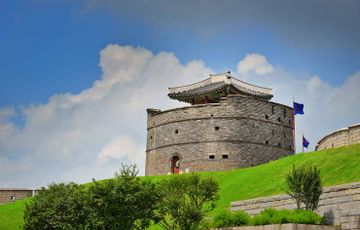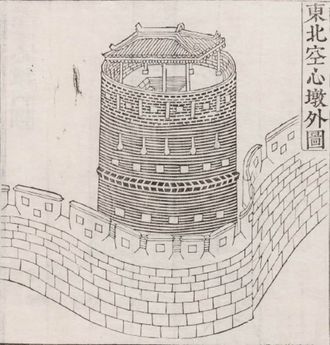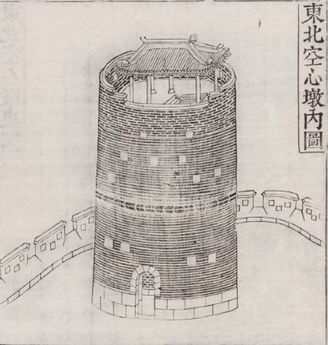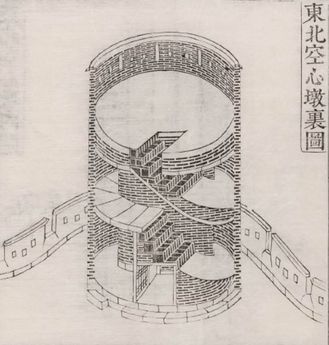수원 화성 - 동북공심돈
| 동북공심돈 東北空心墩 Northeastern Watchtower |
|
수원 화성행궁 안내판 목록으로 가기 |
|
해설문
국문
- 1796년(정조 20) 창건
- 1976년 복원
화성 동북쪽에 세운 망루로 주변을 감시하고 공격하는 시설이다. 공심돈은 속이 빈 돈대라는 뜻으로, 조선시대 성곽중 화성에서만 볼 수 있다. 보통 돈대(墩臺)는 성곽과 떨어진 높은 곳에 세워 적을 감시하는 시설이나, 동북공심돈은 성벽 안쪽에 세웠다.
원통형의 벽돌건물은 3층으로 이루어져 있는데, 출입문에서 통로를 따라 빙글빙글 올라가면 꼭대기 망루에 이르는 구조다. 이 모습을 빗대서 ‘소라각’이라고도 부른다. 외벽에는 밖을 감시하고 화포로 공격할 수 있는 구멍을 곳곳에 뚫었다.
1797년(정조21) 정월, 좌의정 채제공은 동북공심돈을 올라가본 뒤 “층계가 구불구불하게 나 있어 기이하고도 교묘하다.”며 감탄했다. 동북공심돈은 절반 이상 무너져 있던 것을 1976년 복원했다.
영문
This is a watchtower for monitoring the surroundings and attacking enemies. Its Korean name, gongsimdon, means “hollow outpost.” This is because a gongsimdon conventionally has no facilities in its tall brick tower apart from an inner staircase and arrowslits in the walls. In Korea, this kind of watchtower was only constructed in Hwaseong Fortress. There were originally three watchtowers in Hwaseong Fortress, but only two remain today.
The Northeastern Watchtower is the only cylindrical brick building constructed during the Joseon period. It consists of three floors and is topped with a pavilion. It is also called “Soragak,” literally meaning “conch tower,” referring to the shape of the spiral staircase inside. This watchtower was largely destroyed during the Korean War (1950-1953) and was reconstructed in 1976.
영문 해설 내용
공심돈은 주변을 감시하고 적이 오면 공격하기 위한 망루이다. 공심돈이란 '비어있는 돈대'라는 뜻으로, 벽돌로 망루를 높이 쌓고 내부에는 계단을 두며 벽에는 총구멍을 냈다. 이러한 건축물은 한국에서 유일하게 화성에서만 볼 수 있다. 화성에는 원래 세 개의 공심돈이 있었으나 지금은 두 개만 남아있다.
동북공심돈은 조선시대에 만들어진 건물 중 유일한 벽돌조의 원통형 건물이다. 내부는 3층으로 되어 있고, 꼭대기에는 누각을 올렸다. 일명 '소라각'이라고도 불리는데, 내부에 있는 나선형의 계단이 소라처럼 생겼기 때문이다. 동북공심돈은 한국전쟁 중에 크게 파괴되었다가 1976년에 복원되었다.
갤러리
- 『화성성역의궤』 도설 속 그림
VR Tour



